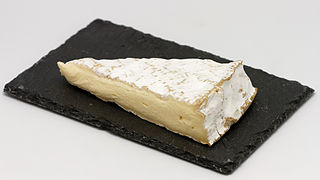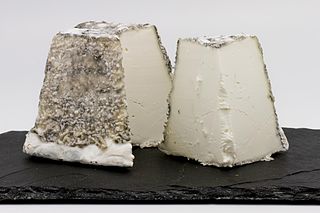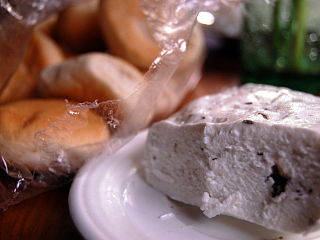
French cuisine is the cooking traditions and practices from France. In the 14th century, Guillaume Tirel, a court chef known as "Taillevent", wrote Le Viandier, one of the earliest recipe collections of medieval France. In the 17th century, chefs François Pierre La Varenne and Marie-Antoine Carême spearheaded movements that shifted French cooking away from its foreign influences and developed France's own indigenous style.

Brie is a soft cow's-milk cheese named after Brie, the French region from which it originated. It is pale in colour with a slight greyish tinge under a rind of white mould. The rind is typically eaten, with its flavour depending largely upon the ingredients used and its manufacturing environment. It is similar to Camembert, which is native to a different region of France. Brie typically contains between 60% and 75% butterfat, slightly higher than Camembert.

Roquefort is a sheep milk blue cheese from southern France. Though similar cheeses are produced elsewhere, EU law dictates that only those cheeses aged in the natural Combalou caves of Roquefort-sur-Soulzon may bear the name Roquefort, as it is a recognised geographical indication, and has a protected designation of origin.

Goat cheese, goat's cheese or chèvre is cheese made from goat's milk. Goats were among the first animals to be domesticated for producing food. Goat cheese is made around the world with a variety of recipes, giving many different styles of cheeses, from fresh and soft to aged and hard.
Vieux-Boulogne is an unpasteurized, unpressed cow's-milk cheese made in the Pas-de-Calais département around the town of Boulogne-sur-Mer in France. It was developed in 1982 by Antoine Bernard and Philippe Olivier.

Pont-l'Évêque is a French cheese, originally manufactured in the area around the commune of Pont-l'Évêque, between Deauville and Lisieux in the Calvados département of Normandy. It is probably the oldest Norman cheese still in production.

Saint-Nectaire is a French cheese made in the Auvergne region of central France.

Cabécou is a soft goat cheese that comes from the Midi-Pyrénées region of southern France. It has a thin striped rind and after two weeks its crust grows blue mold changing its taste. It is one of Aquitaine's most famous foods. Aquitaine is a region in the lower bottom of France. The coloration of this creation is a calm cream color. Cabécou is a cheese generally made from raw goat's milk originating from the regions of the Massif Central such as Quercy, Rouergue, Haute-Auvergne, Limousin and Périgord.

Époisses, also known as Époisses de Bourgogne, is a legally demarcated cheese made in the village of Époisses and its environs, in the département of Côte-d'Or, about halfway between Dijon and Auxerre, in the former duchy of Burgundy, France, from agricultural processes and resources traditionally found in that region.

Rocamadour is a French cheese from the southwest part of the country. It is produced in the regions of Périgord and Quercy and takes its name from the village of Rocamadour in the département of the Lot.

Queso de Valdeón is a Spanish blue cheese from León. The cheese is made in Posada de Valdeón, in the northeast of the province of León, and is wrapped in sycamore maple, or chestnut leaves before being sent to market. The cheese has a very intense blue flavor, but is not as yellowed or as biting as its cousin Cabrales.
Quesillo refers to different Latin American, Spanish, and Filipino foods or dishes depending on the country:

Mottin charentais, previously known as crottin charentais is a French soft double-cream cheese made of pasteurized whole cow's milk, produced by Savencia Fromage & Dairy in the town of Saint-Saviol located within the Vienne department.

Valençay is a cheese made in the historic province of Berry in central France. Its name is derived from the town of Valençay in the Indre department.

Kesong puti is a Filipino soft, unaged, white cheese made from unskimmed carabao milk and salt curdled with vinegar, citrus juices, or sometimes rennet. It can also be made with goat or cow milk. It has a mild salty and tart flavor. When an acidifying agent is used, it resembles queso blanco or paneer. When rennet is used, it resembles buffalo mozzarella. Moisture content can also vary, ranging from almost gelatinous to pressed and firm. It can be eaten as is, paired with bread, or used in various dishes in Filipino cuisine. It is usually sold wrapped in banana leaves.

Maconnais is a small cheese produced in the French region of Burgundy. It is made from either goat's milk or a combination of goat's and cow's milk. Maconnais gained AOC certification in 2005.

The cuisine of Corsica is the traditional cuisine of the island of Corsica. It is mainly based on the products of the island, and due to historical and geographical reasons, has much in common with Italian cuisine, and marginally with those of Nice and Provence.

Limburger is a cheese that originated in the Herve area of the historical Duchy of Limburg, which had its capital in Limbourg-sur-Vesdre, now in the French-speaking Belgian province of Liège. The cheese is especially known for its strong smell caused by the bacterium Brevibacterium linens.
Brousse du Rove is a type of goat cheese, made in the commune of Le Rove in the Bouches-du-Rhône region of France.

















